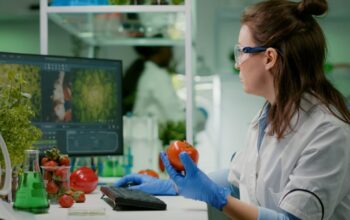The Importance of Food Temperature Monitoring in Ensuring Safety and Compliance
Temperature control is crucial in the food service industry to prevent foodborne illnesses and product spoilage. By properly monitoring temperatures, we can create an environment that is unfavourable for harmful bacteria, stopping them from multiplying quickly in the danger zone between 5°C and 60°C.
Why Temperature Control Matters
Food safety regulations have specific temperature requirements that must be followed:
- Cold foods should always be kept below 5°C
- Hot foods must stay above 60°C
- Frozen products need to be stored at -18°C or lower
If these temperatures are not managed properly, it can pose serious risks to public health. In Australia, around 4.1 million people experience food poisoning every year, and one of the main reasons for this is improper temperature control. Common bacteria such as Salmonella, E. coli, and Listeria thrive when temperatures are not maintained correctly.
Legal Requirements for Food Businesses
According to the law, food businesses must be able to show that they are effectively controlling the temperature of potentially hazardous foods at all times. This includes:
- Regularly checking temperatures
- Keeping accurate records
- Taking immediate action if there are any deviations from the required temperatures
- Documenting how monitoring procedures are carried out
These legal requirements align with international standards such as HACCP (Hazard Analysis Critical Control Points), ISO 22000 Food Safety Management, HARPC (Hazard Analysis and Risk-Based Preventive Controls), and FSMA (Food Safety Modernization Act).
Benefits of Proper Temperature Monitoring
By implementing proper temperature monitoring practices, both businesses and consumers can benefit in several ways:
- Longer shelf life for products
- Preservation of food quality
- Reduction in waste caused by spoilage
- Prevention of expensive product recalls
- Protection of brand reputation
Challenges with Traditional Manual Temperature Checks
Manual temperature monitoring systems present significant operational hurdles in maintaining consistent food safety standards. These traditional methods often fall short of meeting stringent regulatory requirements due to their inherent limitations.
Key Compliance Challenges:
- Inconsistent Monitoring Intervals: Staff members can miss scheduled temperature checks during busy periods or shift changes
- Documentation Gaps: Paper records can be misplaced, damaged, or filled out incorrectly
- Delayed Response Times: Issues might go unnoticed until the next scheduled check
- Limited Data Accessibility: Physical records are difficult to analyse and share across multiple locations
The labour-intensive nature of manual checks creates additional strain on resources. Staff must interrupt their primary duties multiple times daily to perform temperature readings, record the data, and file the paperwork. This process typically takes 15-20 minutes per check, multiplied across different storage units and preparation areas.
Common Human Error Issues:
- Incorrect temperature readings due to rushed measurements
- Illegible handwriting on log sheets
- Backdated entries when checks are missed
- Inconsistent measurement techniques between staff members
The physical demands of manual monitoring can lead to compliance fatigue, where staff might take shortcuts or skip checks entirely during peak business hours. These shortcuts create dangerous gaps in food safety protocols and increase the risk of temperature-related incidents going undetected.
Manual record-keeping systems also make it challenging to demonstrate compliance during audits, as gathering historical data requires sorting through extensive paper records – a time-consuming process that can delay other essential operations.
Advantages of Automated Food Temperature Monitoring Systems
Automated monitoring systems are changing the way we manage food safety. They use advanced wireless sensor technology and continuous tracking capabilities to overcome the challenges of traditional manual monitoring methods.
1. Real-Time Visibility and Control
With automated monitoring systems, you can have complete visibility and control over your food storage conditions at all times. Here’s how:
- Wireless sensors provide 24/7 temperature monitoring across multiple storage units
- Digital dashboards display current conditions and historical data trends
- Remote access enables temperature verification from any location
- Precise measurements accurate to within ±0.5°C
2. Proactive Alert Systems
One of the key advantages of automated monitoring is the ability to receive instant notifications when temperatures go out of range. This allows you to take immediate action and prevent any potential food safety issues. Here’s what you can expect from our alert systems:
- Instant notifications when temperatures deviate from safe ranges
- Multi-channel alerts delivered via SMS text messages, email notifications, phone calls, and mobile app push notifications
- Customisable alert thresholds based on specific food safety requirements
- Escalation protocols ensure urgent issues receive immediate attention
3. Error Reduction and Cost Savings
Manual monitoring methods are prone to human error, which can lead to costly mistakes in food safety management. By implementing automated monitoring technology, you can significantly reduce the risk of errors and save costs in the long run. Here’s how:
- Elimination of manual data entry mistakes
- Automated record-keeping ensures complete documentation
- Reduced labour costs through automated data collection, digital report generation, and streamlined compliance processes
- Prevention of food loss through early detection of equipment issues
4. Enhanced Monitoring Capabilities
Automated monitoring systems offer advanced features that go beyond what manual methods can provide. This allows for more effective management of food storage conditions and better compliance with regulations. Here’s what you can expect:
- Continuous temperature tracking at preset intervals
- Detailed analytics for trend identification
- Historical data storage for audit trails
- Integration with existing food safety management systems
The implementation of automated monitoring technology transforms temperature control from a reactive task into a proactive management system. These sophisticated solutions enable food businesses to maintain consistent storage conditions while creating detailed digital records for compliance purposes. The combination of wireless sensors and automated alerts provides a robust framework for maintaining food safety standards across multiple locations.
See Also : The Best Wireless Temperature Monitoring Systems in Australia
Enhancing Operational Efficiency Through Automation
Automated temperature monitoring systems are revolutionizing business operations by simplifying compliance reporting tasks. This digital transformation eliminates the need for time-consuming manual documentation, resulting in a reduction of reporting time by up to 90%. Staff members can now generate comprehensive compliance reports with just a few clicks instead of spending hours on handwritten records.
Time-Saving Benefits:
- Instant report generation for health inspections
- Automated data compilation for regulatory submissions
- Digital archiving with quick retrieval capabilities
- Simplified audit preparation processes
This significant decrease in administrative workload allows staff to concentrate on critical business functions. Kitchen teams can now focus on food preparation, menu innovation, and delivering exceptional customer experiences. Front-of-house staff also benefit from having extra time to engage with guests and enhance service quality.
Value-Added Activities:
- Enhanced customer engagement
- Improved food presentation
- Menu development and testing
- Staff training and development
- Quality control improvements
The use of data analytics brings predictive maintenance capabilities to food service operations. Advanced monitoring systems analyse equipment performance patterns to identify potential issues before they escalate into costly breakdowns.
Predictive Maintenance Advantages:
- Early detection of refrigeration system inefficiencies
- Identification of temperature fluctuation patterns
- Equipment lifecycle tracking and maintenance scheduling
- Prevention of catastrophic failures
- Reduction in emergency repair costs
These analytical abilities allow for proactive maintenance scheduling during quieter periods, minimising disruptions to operations. The system’s capability to detect subtle changes in equipment performance helps prevent food safety risks and lowers energy consumption through optimised equipment operation.
Moreover, smart algorithms continuously learn from the data collected, improving prediction accuracy and maintenance recommendations over time. This data-driven approach transforms traditional reactive maintenance into a strategic asset management programme, ensuring consistent temperature control while extending the lifespan of equipment.

Comprehensive Compliance Solutions like Squizify
Squizify is leading the way in food safety management with its innovative digital compliance platform. This all-in-one solution transforms traditional compliance processes through customisable checklists and robust auditing capabilities designed for specific business needs.
Key Features of Squizify
The platform offers a range of features to streamline compliance management:
- Tailor-made digital checklists adaptable to different operational requirements
- Real-time automated record-keeping systems
- Advanced auditing tools for thorough compliance tracking
- Customisable reporting templates for regulatory documentation
Seamless Integration with Hardware Components
Squizify’s seamless integration with essential hardware components creates a unified compliance ecosystem. The system connects with:
- Temperature monitoring sensors for continuous environmental tracking
- Label printing systems for accurate food dating and tracking
- Mobile devices for instant data capture and verification
- Cloud-based storage for secure data retention
Versatility Across Industries
The versatility of Squizify extends across multiple industries, each benefiting from its specialised features:
Healthcare Sector
- Temperature monitoring for medical storage
- Compliance tracking for sanitisation protocols
- Documentation of safety procedures
Hospitality Industry
- Food safety compliance management
- HACCP checklist automation
- Equipment maintenance scheduling
Additional Sectors
- Aged care facilities
- Childcare centres
- Supermarket chains
- Manufacturing plants
- Fuel site operations
Continuous Monitoring and Immediate Response
The platform’s 24/7 accessibility through internet-connected devices ensures continuous monitoring and immediate response capabilities. This digital transformation eliminates paper-based systems while maintaining precise compliance records accessible from any location.
Sustainability Benefits of Automated Temperature Monitoring Systems
Automated temperature monitoring systems deliver substantial environmental benefits through advanced technology and data-driven insights. These systems create a positive impact on sustainability initiatives across the food industry through multiple channels:
Minimising Food Waste
- Real-time temperature tracking prevents spoilage by detecting fluctuations before food quality deteriorates
- Precise monitoring enables businesses to maintain optimal storage conditions, extending product shelf life
- Data-driven inventory management helps reduce excess stock and associated waste
Energy Efficiency Optimisation
- Smart sensors analyse refrigeration performance patterns to identify energy consumption trends
- Automated systems detect equipment inefficiencies, enabling proactive maintenance
- Temperature data insights allow for strategic adjustments to reduce power usage during peak periods
- Intelligent monitoring helps maintain ideal temperature ranges without overcooling
Environmental Impact Reduction
- Digital documentation eliminates the need for paper-based temperature logs
- Cloud storage reduces physical storage requirements and associated resource consumption
- Automated record-keeping cuts down on printing supplies and waste
- Remote monitoring capabilities decrease the carbon footprint from manual checks
The implementation of automated temperature monitoring creates a ripple effect of sustainable practices throughout operations. These systems enable businesses to track their environmental impact through detailed analytics while simultaneously reducing operational costs and improving efficiency.
Ensuring Data Security and Accessibility with SaaS Platforms
Modern SaaS platforms are changing the game for food temperature monitoring with their strong security measures and easy access to data. These cloud-based systems use military-grade encryption to keep sensitive compliance data safe, making sure that:
- Temperature records are stored securely
- No one can access the data without permission
- Backups are done automatically on a regular basis
- Data protection laws are being followed
Always Available Access
The 24/7 accessibility feature enables authorised personnel to:
- Access real-time temperature data from any location
- Review historical compliance records instantly
- Generate automated reports on-demand
- Respond swiftly to temperature alerts
Food safety managers can make quick and informed decisions using devices connected to the internet, whether they’re dealing with temperature changes or doing routine compliance checks. The cloud-based setup not only gets rid of the risk of losing data that comes with physical storage systems while still keeping a secure record for regulatory purposes, but it also provides an opportunity for secure cloud storage for sensitive data.
Keeping Everyone in the Loop
These platforms support multi-device compatibility, allowing staff to monitor temperatures through:
- Mobile phones
- Tablets
- Desktop computers
- Smart devices
The centralised data management system creates a single source of truth for all temperature-related information, streamlining compliance processes and enhancing operational efficiency.
Case Study Examples Demonstrating the Effectiveness of Integrated Monitoring Systems
The implementation of integrated monitoring systems has transformed food safety management across various industries. Here are two case studies that highlight the effectiveness of such systems:
1. Major Restaurant Chain: SmartSense by Digi
A major restaurant chain deployed SmartSense by Digi across 500 locations, resulting in significant improvements:
Results achieved:
- 30% reduction in food waste
- 25% decrease in labour costs
- 99.98% compliance rate with temperature monitoring requirements
- Zero food safety incidents in 12 months
The success can be attributed to the seamless integration between wireless sensors and digital HACCP checklists, which created a robust system for maintaining food safety standards. Staff members now complete digital checklists through mobile devices, with temperature readings automatically populated from wireless sensors.
2. Healthcare Facility: Transition from Paper-based Systems to Digital Monitoring
A healthcare facility implemented an integrated monitoring system, leading to additional benefits:
“The transition from paper-based systems to digital monitoring saved our staff 15 hours per week while improving our audit readiness” – Healthcare Facility Manager
The system’s enterprise features proved particularly valuable:
- Extended Battery Life: Sensors operate continuously for 12+ months
- Secure Data Transmission: 256-bit encryption ensures data integrity
- Automated Incident Management: Smart alerts trigger immediate corrective actions
- Real-time Documentation: Digital records update automatically with each reading
These real-world applications demonstrate how integrated solutions streamline compliance processes while enhancing accuracy and reliability. The combination of wireless sensors with digital checklists creates a comprehensive monitoring system that adapts to diverse operational environments.

Conclusion
Automated food temperature monitoring systems are a game-changing investment in modern food safety management. These technologies offer significant benefits in various operational areas:
- Improved Safety Standards: With real-time monitoring and immediate alerts, costly food safety incidents can be prevented, ensuring consumer health is protected.
- Simplified Compliance: Automated documentation and reporting features guarantee compliance with regulatory requirements.
- Increased Efficiency: By reducing manual tasks and optimising resource allocation, substantial cost savings can be achieved.
- Less Waste: Data-driven insights enable proactive maintenance, minimising food spoilage.
In today’s competitive food service industry, businesses must adopt digital temperature monitoring solutions to stay ahead. These systems provide a strong foundation for managing risks and enhancing product quality.
Ready to transform your food safety operations? Book a demo with Squizify today to discover how automated temperature monitoring can enhance your compliance processes and protect your bottom line. Explore the possibilities of streamlined food safety management backed by cutting-edge technology.


